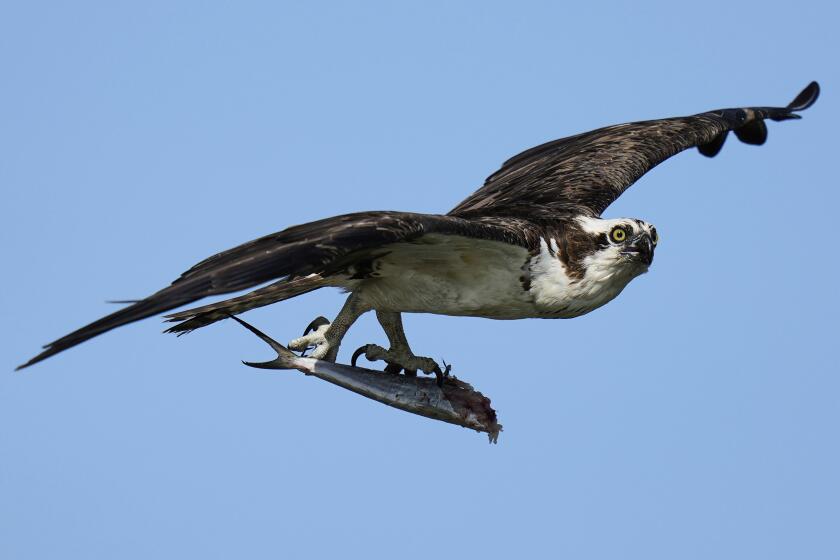Osprey's Comeback Under Threat as Chicks Die in Nests

Osprey Population Decline Linked to Menhaden Shortage
Bryan Watts, a biologist with a deep connection to ospreys, stands on an old wooden duck blind in the middle of the York River. He gazes at a circle of sticks and pine cones on a weathered platform covered in guano. This is a failed osprey nest that has been taken over by diving terns.
“The birds never laid here this year,” Watts says near the mouth of Virginia’s Chesapeake Bay. “And that's a pattern we've been seeing these last couple of years.”
Watts has spent decades studying ospreys, climbing their nests to free them from plastic bags, feeding them by hand, and monitoring their eggs with telescopic mirrors. The fish-eating raptor, known for its acrobatic dives and whistle-like calls, is a symbol of American conservation success. After pesticides nearly wiped out the species, it rebounded after the ban of DDT in 1972, with thousands now living across the U.S.
However, Watts has noticed a troubling trend: ospreys are failing to successfully raise enough chicks around the Chesapeake Bay, which is a key population center. He attributes this decline to the shrinking numbers of menhaden, a small fish critical to the osprey diet. Without enough menhaden, chicks are starving and dying in nests.
Osprey as Environmental Indicators
Watts’s findings have put him and environmental groups at odds with the fishing industry, trade unions, and some government regulators. Menhaden is a valuable resource used for fish oil, fish meal, agricultural food, and bait. U.S. fishermen have caught at least 1.1 billion pounds of menhaden annually since 1951. Industry representatives argue that the decline in osprey may not be linked to fishing and emphasize the sustainability of the practice.
But Watts warns that without intervention, the osprey population could drop to levels not seen since the days of DDT. “The osprey are yelling pretty loudly that there's not enough menhaden for us to reproduce successfully,” he said. “We should be listening to them to make more informed decisions about fisheries management.”
Studies Show Link Between Menhaden and Osprey Survival
Watts has supported his claims with scientific studies published in journals. He highlights a simple statistic: to maintain their population, osprey pairs need to average 1.15 chicks per year. In the 1980s, osprey were reproducing at that level, but today, in some areas around the main stem of the Chesapeake, it’s less than half that number. In particularly affected regions, they’re not even reaching one-tenth of that level, according to Watts.
Menhaden, also known as pogies or bunkers, are especially important for young ospreys because they are more nutritious than other fish. Watts wrote in a 2023 study published in Frontiers in Marine Science that “osprey reproductive performance is inextricably linked to the availability and abundance” of menhaden.
Industry Pushes Back Against Conservation Concerns
Menhaden support one of the world’s largest fisheries, valued at over $200 million in 2023. They are essential for commercial fishing targets like Maine lobster and are popular among sportfishermen. The industry is dominated by Omega Protein, a company based in Virginia that processes menhaden harvested by Ocean Harvesters.
Industry representatives argue that other factors, such as climate change, pollution, and development, could be responsible for the osprey decline. Ben Landry, a spokesperson for Omega, noted that federal data show osprey breeding is in decline in many parts of the country, including areas where menhaden is not harvested at all. “Blaming fishing just reeks of environmental special interest groups having an influence over the process,” he said.
Potential New Regulations on the Horizon
The menhaden fishery is managed by the Atlantic States Marine Fisheries Commission, an interstate body that sets fishing quotas and rules. In response to concerns about osprey populations, the commission formed a work group to explore precautionary management strategies for the Chesapeake Bay.
In April, the group proposed several potential approaches, including seasonal closures, quota restrictions, and gear limitations. The process of creating new rules could begin this summer, according to James Boyle, a fishery management plan coordinator with the commission.
While the osprey population has declined in some areas since 2012, Boyle emphasizes that the bird’s numbers are still much higher than before the DDT ban. Federal data show a six-fold increase in osprey populations along the Atlantic Coast since the 1960s.
Environmentalists Warn of Further Decline
Environmental groups argue that any decline is too much, despite the economic concerns of some labor leaders. Kenny Pinkard, a retired fisherman and former union leader, feels the industry is being unfairly targeted. “There are some people who just don't want to see us in business at all,” he said.
Chris Moore, Virginia executive director for the Chesapeake Bay Foundation, warns that the loss of ospreys could have lasting consequences. “Osprey have been a success story,” he said. “We're in a situation where they're not replacing their numbers. We'll actually be in a situation where we're in a steep decline.”
Komentar
Posting Komentar